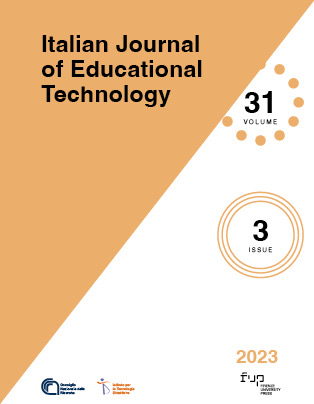Inclusive science communication: Tools from the natural sounds
Main Article Content
Abstract
Scientific popularization for people with sensory disabilities is today insufficient and lacking in specific methods as it uses contents rich in visual and abstract references, difficult to assimilate by those with perceptual or sensory deficiencies. This research aims to fill the gap through an exploratory case study, conducted with an inclusive and multisensory method. This method is based on the use of natural sounds to communicate complex concepts related to ecology and environmental vulnerability. It has a bottom-up approach, starting from a single theme to arrive at the definition of ecosystems and environmental emergencies. The results indicate that natural sounds contribute to students’ learning by improving the ability to recognize and describe ecological and environmental issues. The proposed method was highly appreciated by the participants and exhibits excellent performance and great expandability to complex themes.
Article Details
Section
Authors who publish with this journal agree to the following terms:
- Authors retain copyright and grant the journal right of first publication with the work simultaneously licensed under a Creative Commons CC BY 4.0 Attribution 4.0 International License.
- Authors are able to enter into separate, additional contractual arrangements for the non-exclusive distribution of the journal's published version of the work (e.g., post it to an institutional repository or publish it in a book), with an acknowledgement of its initial publication in this journal.
- Authors are permitted and encouraged to post their work online (e.g., in institutional repositories or on their website) prior to and during the submission process, as it can lead to productive exchanges, as well as earlier and greater citation of published work (See The Effect of Open Access)
References
Ahmetovic, D., Alampi, V., Bernareggi, C., Gerino, A., & Mascetti, S. (2017). Math melodies: supporting visually impaired primary school students in learning math. Proceedings of the 14th Web for All Conference on The Future of Accessible Work. W4A 2017 April 02-04, 2017. Perth, Australia: ACM. https://doi.org/10.1145/3058555.3058583
Anđić, B., Cvjetićanin, S., Maričić, M., & Stešević, D. (2019). Sensory perception and descriptions of morphological characteristic of vegetative plant organs by the blind: implementation in teaching. Journal of Biological Education, 55(3), 321-339. https://doi.org/10.1080/00219266.2019.1687107
Anđić, B., Lavicza, Z., Ulbrich, E., Cvjetićanin, S., Petrović, F., & Maričić, M. (2022). Contribution of 3D modelling and printing to learning in primary schools: a case study with visually impaired students from an inclusive Biology classroom. Journal of Biological Education. https://doi.org/10.1080/00219266.2022.2118352
Baron, S., Sinclair, R., Payne-Sturges, D., Phelps, J., Zenick, H., Collman, G.W., & O’Fallon, M.A. (2009). Partnerships for environmental and occupational justice: contributions to research, capacity and public health. American Journal of Public Health, 99 Suppl 3(S3): S517-25. https://doi.org/10.2105/AJPH.2009.174557
Beck-Winchatz, B., Riccobono, M.A. (2008). Advancing participation of blind students in Science, Technology, Engineering, and Math. Advances in Space Research, 42(11): 1855-1858. https://doi.org/10.1016/j.asr.2007.05.080
Bickford, D., Posa, M. R. C., Qie, L., Campos-Arceiz, A., & Kudavidanage, E. P. (2012). Science communication for biodiversity conservation. Biological Conservation, 151, 74-76. https://doi.org/10.1016/j.biocon.2011.12.016
Bourne, R., Steinmetz, J. D., Flaxman, S., Briant, P. S., Taylor, H. R., Resnikoff, S., … Afshin, A. (2021). Trends in prevalence of blindness and distance and near vision impairment over 30 years: an analysis for the Global Burden of Disease Study. The Lancet Global Health, 9(2), 130-143. https://doi.org/10.1016/S2214-109X(20)30425-3
Businaro, N., Pons, F., & Albanese, O. (2015). Do intelligence, intensity of felt emotions and emotional regulation have an impact on life satisfaction? A quali-quantitative study on subjective wellbeing with Italian children aged 8–11. Child Indicators Research, 8(2). https://doi.org/10.1007/s12187-014-9250-x
Cohen, L., Manion, L., Morrison, K. (2000). Research Methods in Education. Eighth edition Taylor & Francis Group, Routledge. https://doi.org/10.4324/9780203224342
Dalziell, A. H., Welbergen, J. A., Igic, B., & Magrath, R. D. (2014). Avian vocal mimicry: a unified conceptual framework. Biological reviews of the Cambridge Philosophical Society, 90(2), 643-658. https://doi.org/10.1111/brv.12129
Ducarme, F., Luque, G. M., & Courchamp, F. (2013). What are “charismatic species” for conservation biologists? BioScience Masters Reviews. Ecole Normale Supérieure de Lyon, 10(1), 1-8. Retrieved from https://www.researchgate.net/publication/302596828_What_are_charismatic_species_for_conservation_biologists#full-text
Duckett, P. S., & Pratt. R. (2001). The Researched Opinions on Research: Visually Impaired People and Visual Impairment Research. Disability & Society, 16(6), 815–835. https://doi.org/10.1080/09687590120083976
Flórez-Aristizábal, L., Cano, S., Collazos, C. A., & Moreira, F. (2018). Digital transformation to support literacy teaching to deaf children: from storytelling to digital interactive storytelling. Telematics and Informatics, 38, 87-99. https://doi.org/10.1016/j.tele.2018.09.002
Fraser, W.J., & Maguvhe, M.O. (2008). Teaching life sciences to blind and visually impaired learners. Journal of Biological Education, 42, 82–89. https://doi.org/10.1080/00219266.2008.9656116
Jones, R.W. (2006). Problem-based learning: Description, advantages, disadvantages, scenarios and facilitation. Anaesthesia and Intensive Care, 34(4), 485-488. https://doi.org/10.1177/0310057X0603400417
Lesen, A. E., Rogan, A., & Blum, M. J. (2016). Science communication through art: objectives, challenges, and outcomes. Trends in ecology and evolution, 31, 657-660. https://dx.doi.org/10.1016/j.tree.2016.06.004
Mills, A. J., Durepos, G., & Wiebe, E. (2010). Encyclopedia of Case Study Research, Volumes I and II. Thousand Oaks, CA: Sage.
Papadopoulos, K., Barouti, M., & Koustriava, E. (2018). Differences in spatial knowledge of individuals with blindness when using audio-tactile maps, using tactile maps, and walking. Exceptional Children, 84, 330–343. https://doi.org/10.1177/0014402918764300
Pijanowski, B.C., Villanueva-Rivera, L.J., Dumyahn, S.L., Farina, A., Krause, B.L., Napoletano, B.M. … Pieretti, N. (2011). Soundscape ecology: the science of sound in the landscape. Bioscience, 61(3): 203–216. https://doi.org/10.1525/bio.2011.61.3.6
Rios-Chelen, A. A., Salaberria, C., Barbosa, I., Macias Garcia, C., & Gil, D. (2012). The learning advantage: bird species that learn their song show. Journal Evolutional Biology, 25, 2171–2180. https://doi.org/10.1111/j.1420-9101.2012.02597.x
Setti, W., Cuturi, L.F., Cocchi, E., & Gori, M. (2018). A novel paradigm to study spatial memory skills in blind individuals through auditory modality. Scientific Reports, 8. Retrieved from https://www.nature.com/articles/s41598-018-31588-y
Suimuek, O., Altun, E., & Ateu, A. (2010). Developing ICT skills of visually impaired learners. Procedia Social Behaviour Science, 2, 4655-61. https://doi.org/10.1016/j.sbspro.2010.03.745
Wallerstein, N., & Duran, B. (2010). Community-based participatory research contributions to intervention research: the intersection of science and practice to improve health equity. American Journal of Public Health, 100(Suppl. 1), S40-S46. https://doi.org/10.2105/AJPH.2009.184036
Yin, R. K. (2018). Case Study Research and Applications: Design and methods (6th ed.). Thousand Oaks, CA: Sage.

